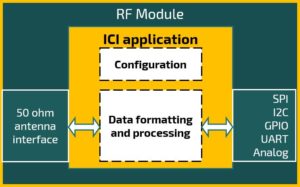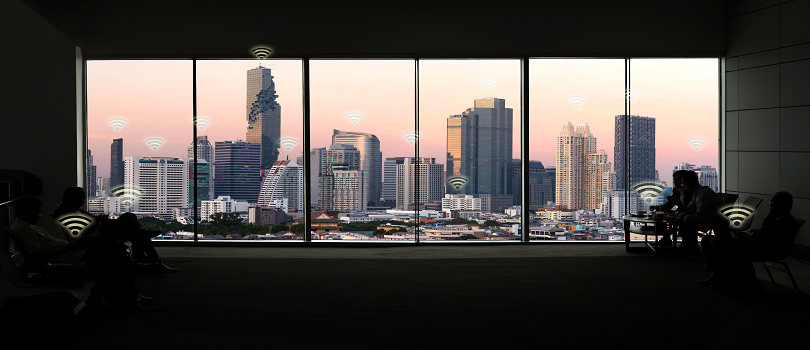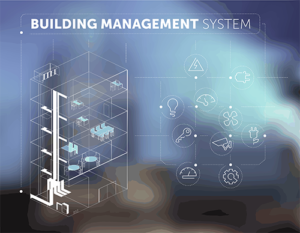Energy Management… Everyone at some point in their lives have heard of this term, especially in recent years, where saving energy is becoming paramount to the future of organizations worldwide and planet Earth itself. Much of the importance in saving energy stems from a global need to save energy which affects global energy prices, emission targets, and legislations, all of which are compelling reasons why an organization should take energy saving strategies seriously. On a global scale, energy saving is important to reduce the damage that we are causing to our planet and to reduce our dependence on various fossil fuels which are becoming increasingly limited in supply.
Therefore, in this blog post we will discuss, more specifically, what a Building Energy Management System (BEMS) actually is and why these systems are becoming important and popular amongst organizations worldwide. Then we will go into detail on how to properly implement an efficient BEMS into our own organizations, and finally, we will introduce Radiocrafts’ new product line, RIIM™, as an important contribution to this industry.
What is a Building Energy Management System?
A Building Energy Management System is an integrated, computerized system for monitoring and controlling energy-related building services, plant, and equipment such as heating, ventilation, and air-conditioning (HVAC) systems, lighting, power systems, and so on.
 A small building typically has independent controls for energy systems, however for larger, more complex buildings, or organizations with many buildings, the integration of system operations through a single building energy management system, offers greater control and can improve on energy savings significantly. BEMS provides real-time control and monitoring of a wide range of connected systems, environmental conditions, energy use, and more. You can then collect and analyse all this data to create a more comfortable and energy-friendly environment in the building. Another great feature of building energy management systems is that they can trigger alarms when there is a malfunction in equipment allowing quick and even predictive maintenance to occur. They even record historical performance and enable benchmarking of performance against other buildings.
A small building typically has independent controls for energy systems, however for larger, more complex buildings, or organizations with many buildings, the integration of system operations through a single building energy management system, offers greater control and can improve on energy savings significantly. BEMS provides real-time control and monitoring of a wide range of connected systems, environmental conditions, energy use, and more. You can then collect and analyse all this data to create a more comfortable and energy-friendly environment in the building. Another great feature of building energy management systems is that they can trigger alarms when there is a malfunction in equipment allowing quick and even predictive maintenance to occur. They even record historical performance and enable benchmarking of performance against other buildings.
Another crucial part of BEMS is the use of sensors. Sensors monitor operational conditions of buildings and building equipment. Examples include monitoring airflow in the building, sunlight exposure, temperature, and much more. Then, device controllers process all this collected data and actuators perform the appropriate actions to optimize the environmental settings. So, now that we have discussed what BEMS are, why are they becoming so important for business?
Why are Building Energy management Systems Important and Popular Amongst Organizations Worldwide?
In 2014, BSRIA reported that the global BEMS market was worth $3.5 billion, or 3 billion Euros, and was growing globally at more than 10% per annum. This increasing interest has resulted from the rising cost of fuel, concerns over energy security, increasingly aggressive environmental targets and the reduced cost of sensors, analytics software and data storage.
An efficient building energy management system can save 10% to 30% in energy without compromising comfort or performance. Technology is evolving at an exceptional rate, but specifically for BEMS, automation is becoming increasingly important to optimize our day-to-day business activities and goals. The need for integrating smart automation systems with our modern infrastructure is encouraging many building management system companies improve the quality and effectiveness of their solutions to appease the ever-growing audience in this industry. So, when we talk about and effective BEMS solution, what does that entail?
How To Properly Implement A Building Energy Management System Into Our Own Organizations?
In order to function correctly, a BEMS must be continually assessed and fine-tuned as performance is normally better understood over longer periods of time. Another important factor to consider is continuous maintenance. This means replacing batteries for sensors, checking connections, checking the operation of valves, upgrading software, and much more.
When it comes to collecting energy-related data, a building energy management system will do much more than a typical energy audit. An energy management system will centralize and analyze that data, so you can make informed decisions about both immediate energy saving possibilities as well as future, large-scale energy saving products that you can invest in.
There are 3 main ways to manage energy inside a building:
- Energy Conservation – Energy conservation refers to reducing your building’s energy use by eliminating energy waste, through economy or through more rational use.
- Energy Recovery – Energy recovery refers to the reuse of one system’s energy byproduct for the input energy of another system. For example, using waste heat that’s generated from a manufacturing process for a completely different purpose, such as heating your building’s water.
- Energy substitution – Energy substitution is the method of replacing a source of energy or fuel with one that is more economical or less polluting.
A comprehensive energy management system should provide:
- The ability to gather data from every available energy source, whether it’s old, new, integrated or stand-alone.
- The ability to identify problems and trends by analyzing both single-variable and multi-variable data.
- The ability to provide alerts if your building’s energy consumption exceeds the parameters you established.
- The ability to integrate with control systems to automate responses and input data.
- The ability to provide early warnings for any mechanical or electrical failures.
- The ability to identify energy waste and to recommend fixes, allowing for easier payback.
- The ability to benchmark your building’s energy use against other buildings in similar climates.
Other important features of an efficient BEMS system includes:
- Having flexible infrastructure connections which allow your monitoring and control devices to connect to new or existing systems.
- It should have an inclusive system control where the entire system can be controlled from a single application.
- Your BEMS should be able to collect external data feeds such as information from the weather or utility billing to provide a more complete view of energy use.
- The best BEMS software also take into account building dimensions, allowing you to parameter building connections and input additional information such as surface area and occupancy.
So, now that we have shared a glimpse into what an effective building energy management system looks like, what contributions has Radiocrafts made to this industry?
RIIM By Radiocrafts – An Effective Solution For Building Energy Management Systems
Radiocrafts has acknowledged that Building Energy Management systems play an essential role in enabling Smart Cities. Therefore, we have targeted this market with our latest product line called RIIM by Radiocrafts (Radiocrafts Industrial IP Mesh).
A main requirement for an effective Building Energy Management System is to have an effective wireless RF device which can reliably send data within the infrastructure. The main requirements on the RF connection side are that the device must be easy to install and maintain, and supports long range and long coverage.
RIIM by Radiocrafts is an Industrial IoT wireless IP mesh network completely embedded in a module and developed for you to easily create your own industrial grade access network with direct IP connectivity. It supports all of the above-mentioned required features to create an efficient BEMS system which we will take a deeper look into now.
 RIIM by Radiocrafts has an incredibly short development time and is easy to install and maintain. With Radiocrafts’ ICI Framework, which is embedded in the IPM module, you can quickly and easily create a smart autonomous network sensor node which can read and manage any sensor you can think of. It has a level of abstraction so high that you can program a complex data processing application in less than 100 lines of high-level C-code with no need for knowledge of low-level programming. ICI is completely embedded in the RF module meaning there is no need for supporting circuitry. Read more about ICI and its vast capabilities here.
RIIM by Radiocrafts has an incredibly short development time and is easy to install and maintain. With Radiocrafts’ ICI Framework, which is embedded in the IPM module, you can quickly and easily create a smart autonomous network sensor node which can read and manage any sensor you can think of. It has a level of abstraction so high that you can program a complex data processing application in less than 100 lines of high-level C-code with no need for knowledge of low-level programming. ICI is completely embedded in the RF module meaning there is no need for supporting circuitry. Read more about ICI and its vast capabilities here.
All the customer has to do is pick the sensor chip and units he wants to control, design the child node box mechanics, design his/her ICI application in high level C-programming, then connect the network to the internet via a Border Router, and DONE! Creating a smart autonomous network node has never been so easy, as it is with ICI! The installation is completely automatic and the network is self-healing and self-optimizing so it requires no setup at installation. It is a plug-and-play solution ensuring quick deployment and low maintenance requirements.
RIIM by Radiocrafts supports long range and great coverage networks. RIIM’s range in urban environments can reach up to 700 meters which is sufficient for even the most complicated building energy management systems. Additionally, it supports 29 mesh hops which means that RIIM can cover a whopping area of up to 40 by 40 kilometres squared. This is effective if your organization owns a cluster of buildings in an area and wants all these buildings to communicate with each other.
Each node in RIIM has its own IP address and is connected via CoAP. This means that a Cloud application can talk directly to an individual node without a complex data or address translation in a gateway. This also means that end to end security is supported via DTLS in RIIM when a Cloud connection is available.
Click here to read more about RIIM by Radiocrafts.
What To Take Away From This?
What you should take away from this blog post is that our energy consumption requirements are changing. The rising cost of fuel, concerns over energy security, the health of our planet, have shifted the way think about and use energy. We are now, more than ever, trying to save as much energy as possible for a sustainable future. This can be seen in the way technology and business is evolving. We now have Building Energy Management Systems which can help an organization save up to 10% – 30% of their current energy consumption. This can only be achieved with an efficient BEMS which allows us to efficiently monitor and control the use of our buildings’ lights, ventilation devices, and more in order to make smarter decisions on energy-related issues. Radiocrafts has now also joined the BEMS market by providing a new module, RIIM, as an efficient BEMS solution due to the ease of installing and maintaining the network, the support for most cloud applications, and the long range and great coverage that RIIM offers.





